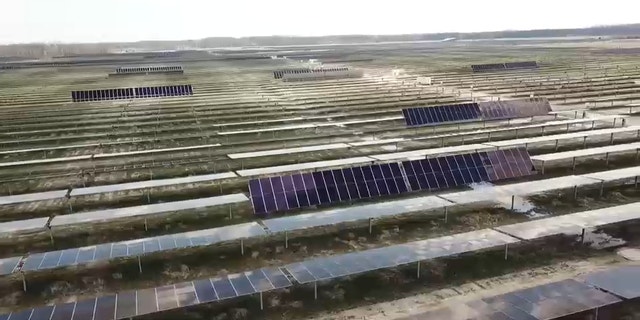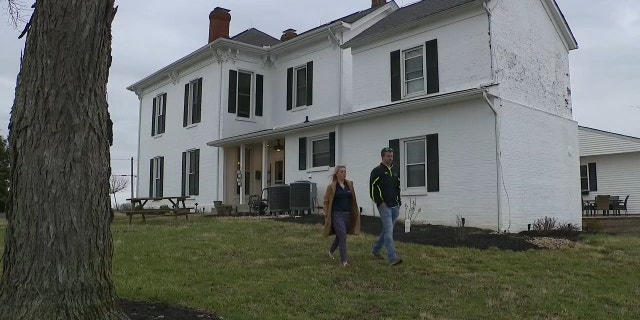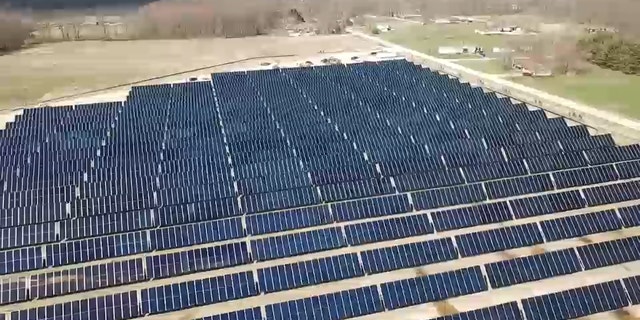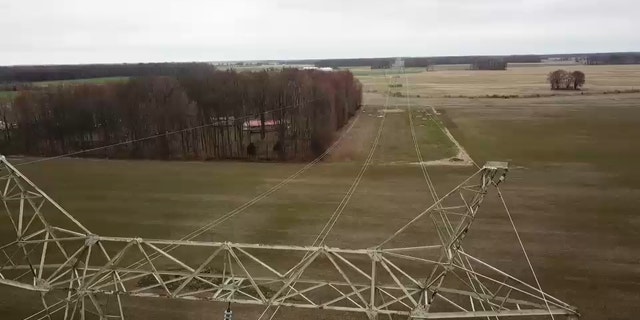Deep-red rural Ohio's solar energy boom divides farming communities

Energy companies leasing farmland to produce solar power
Some farmers are skeptical of the projects; FOX News correspondent Mark Meredith reports from Mount Orab, Ohio
Brad Cochran is raising his family in the same farmhouse his grandparents once shared. The Cochran home in Martinsville, Ohio, is an old, stately white house with black shutters surrounded by gently rolling open fields. Traffic only occasionally passes. Despite the house being sold to owners outside his family for over a decade ago, through some persistence, Cochran and his wife, Dani, were able to convince the previous owners to sell it to them.
They now have a 3-year-old son and a 4-month-old daughter and call the home they all share together “a work in progress,” an ode to their desire to continually build upon their lives.
A third-generation farmer, Cochran works full-time at his 3,500-acre farming operation, while also building his part-time real estate career so that he can pass along the only way of life he’s ever known to his children someday.
While the number of family farms are dwindling across the U.S., Cochran is carrying on his legacy in a rural county that is still home to many of them. Clinton County’s 700 farms are almost entirely family-owned. Determined to battle the uncertain future of their industry, with trade wars and food prices fluctuating beyond their control, farmers also cope with the same unpredictable weather that also plagued their ancestors. But, Cochran and farmers around the country are, or soon will be, facing yet another difficult decision about their livelihood: the increasing development of solar farms.
Hillcrest Solar Project leased over 2,000 acres in Brown County, Ohio, where some residents have homes in close proximity to the 600,000 solar panels.
(Fox News)
In Ohio, renewable energy companies are developing 34 utility-scale solar projects all over the state. Experts expect to see more, especially in the southern Appalachian counties where over a quarter of these projects are based. This is also where Cochran works and lives.
“Ohio is still very much in a growth stage with solar, and we should expect additional projects to come forward,” says Daniel Sawmiller, the National Resource Defense Council’s Ohio energy policy director. He says that the majority of the state’s solar development has taken place in southwest Ohio, partly due to the retirement of coal resources in the region, but also because the area is in need of investment. “The Appalachian part of our state has in many ways has been neglected for years. This new development is creating tens of thousands of construction jobs in areas of our state that badly need them and is driving significant new tax revenue to Ohio’s rural schools, townships, and local county general revenue funds.”
One renewable energy company, Canada’s Innergex, owns Hillcrest farm in Brown County, a solar farm only weeks away from becoming fully operational. The company’s director of development, Bill Behling, recently visited the 2,100-acre site.
“It’s the available farmland. It’s the access to the transmission grid. And this is among the best solar resource in the state,” Behling said.
Aerial view of Hillcrest Solar Project in Brown County, Ohio.
(Fox News)
While his company continues to invest in Ohio, it’s also investing in many other states as the Biden administration ramps up demand for renewable energy countrywide. Behling is currently working on Innergex’s second project in the region, just a short distance from Hillcrest. Highland County’s Palomino Project will be located on 2,800 acres, which Behling acquired by asking local farmers to lease their land for 30 years.
“We’re offering them a stable source of income, the use of their property and their choice if they want to convert this essentially to solar energy for 30 years after which time we’ll decommission this site, we’ll take out all the equipment, and then we’ll revert back to farmland,” Behling says. “It stays in the family. For many of them, it’s a decision-maker to keep the farmland, keep the property in the family, but they still have suitable income.”
BIDEN AGRICULTURE SECRETARY NOMINEE WANTS FARMERS ON FRONT LINE OF CLIMATE CHANGE
That was the case for several families who signed up with Behling’s company.
“It was our father’s wishes at his death for the farm to remain in the bloodline. As we have no children that followed the farming career, this project has afforded us the opportunity to fulfill his wishes by heritance after our death. We thank you for this project which helps keep the farm in the Holman bloodline,” reads one entry on record from the project’s 2017 public comment period.
But farmers and residents who did not lease their land to a solar project, or didn’t have the opportunity to, are left to live beside the solar panels. Others worry about the developments are too concentrated in one area. From a public comments filed with the state on a solar development in Highland County, a resident asked, “Is there a limit to how much ground solar companies can consume in one township, county or state? I notice a lot of solar farms potentially going up within the area.”
“It would be nice if some of these solar farms were developed in other parts of the state instead of putting them all here, in our neighborhoods. The size of these three projects and the amount of farmland they will occupy are vast,” reads another.
Brad and Dani Cochran outside their farmhouse in Martinsville, Ohio.
(Fox News)
One entry says, “My husband is a farmer and we both love the country life and wanted a nice, beautiful, peaceful setting to raise our family. … We found out about this solar project, through the grapevine of our country friends, a few months ago. The company and the people they sold it to did a good job of keeping it a secret. I was completely devastated when my husband told me. We had just finished building an addition on our house. We’ve spent years making it nice and doing projects, and now I’m not sure we will even be able to sell it when the time comes. No one will want to stare at panels on four sides of their house.”
Cochran, too, worries about the impacts from two solar farms that are currently going through the Ohio Power Siting Board’s approval process and will be neighboring land he farms. One is Behling’s project, Palomino, and the other is Invenergy’s Yellow Wood project, which has acquired 4,395 acres from 13 landowners in Clinton County. Cochran was approached about leasing farmland that he owns as well, but his family ultimately decided not to, although he admitted the offers were enticing.
“This has definitely driven a wedge between neighbors and that’s frustrating,” he says. “It’s not something we’re anticipating having to deal with. And, you know, these are friends and neighbors and people we’ve known our entire lives. The scary part is the amount of money that has been thrown at these projects. It’s absolutely tempting.”
Aerial view of Hillcrest Solar Project in Brown County, Ohio.
(Fox News)
Cochran’s concerned for his own livelihood, as he depends on landowners to lease land to him and wants to continue to grow his operation. He says at least half of the landowners he currently rents from have been approached by solar companies. But he also wonders what this means more broadly for his community and the country.
“Everyone jokes farming is in your blood and it’s what we do. It’s the only thing we know how to do. Part of that is dealing with the good times and dealing with the bad. I’m just afraid that when these solar companies come in, this ground will never get returned back to its original state. it’ll never be as productive as it once was once these solar panels have come and gone. And that’s something that again, people may not realize. And you think in the short term, you think in short term dollars then figure out the rest later.”
The impact on productive farmland is on the minds of many local farmers. Although each solar company is required by the state to set aside money for removing the panels one day, farmers who spend their lives nurturing soil think that the promise these companies are making — that they can convert the land back to tillable land after the 30-year lease expires — is nearly impossible. Multiple farmers argue that the land was tilled for generations to get it to the productive state it is now in, and the impacts from the construction will not go away overnight.
“They’re not leasing the marginal ground, the hillsides, the highly erodible land. They’re leasing the prime stuff,” Cochran said. “The same reason we don’t want to lose these farms is the reason that they want them.”
The Cochran family farmhouse in Clinton County, Ohio, will soon be near a large utility-scale solar project that has leased over 4,000 acres of farmland in the area.
(Fox News)
Brown County’s Hillcrest project has been under construction for nearly 18 months. Locals who live next to the project filed complaints about the site’s noise levels, drainage problems, and mud on the roads. Some complaints ranged from “difficulty seeing road lines due to dirt,” to “dust and headlights” shining into homes, and elderly who cited “ill effect” on sleep. In one case, to mitigate noise impacts, Hillcrest installed air conditioning units in one residence that previously was only able to open their windows during hot summer months.
Sawmiller reminds Ohioans that these impacts are temporary. “While solar energy has some temporary construction nuisance associated with it — like any type of development — it’s really one of the most benign uses of the land you could imagine. Once operational, there’s no noise, no pollution, no water discharge, and no traffic.”
The state has jurisdiction over the approval of these projects and stipulates numerous studies that the company must complete before commencing construction. The Ohio Power Siting Board’s Matt Shilling notes that public information meetings are mandatory, and that “communities may file as intervening parties” in the hearing process. However, there is controversial legislation on the state level to subject these projects to community referendum, allowing townships to vote on a particular project. Some say that this will give a much-needed voice to a process believed to go under the radar, especially during the coronavirus pandemic when many of the public meetings were conducted virtually. Opponents of the measures say that it would be an infringement on the rights of local property owners and designed to stop solar development.
Despite these requirements and promises, as solar development make its way into rural communities, many local officials and residents Fox News spoke with privately expressed uncertainty if their new neighbors would live up to their promises. These solar projects, still in the early stages of development, have not yet been around long enough to weigh the long-term impacts.
Ohio’s solar boom is due to the area’s flat, inexpensive land, strong solar resources, and proximity to transmission lines like this one in Highland, County Ohio, near Cochran’s farmland.
(Fox News)
“There is some uncertainty as to whether the solar project will keep the tax base intact in that area of the county. The company suggests the solar will bring more money to the township, the schools, and the county. I am skeptical yet hopeful this will be the case. In a small county we all rely heavily on that tax base to cover the day-to-day operation,” said Brown County Auditor Jill Hall.
For Cochran, who simply wants to continue the type of life that his ancestors passed down to him, loves the place where he grew up and wonders if it’ll be the same for his son.
“I’ve got a 3-year-old son who is obsessed, infatuated with everything to do with this farm. He sleeps and breathes it. You know, if he’s not riding a tractor with me, he’s out in the yard playing with his farm toys. And I guess I’m afraid they’re going to inherit a mess, you know, someday. No one has seen one of these projects run its course. You know, they’ve never gotten one up and going and then decommissioned it and tore the panels back out to know what the long-term effects are. And it’s a lot of the unknowns that that really are scary.”
Source: Read Full Article







